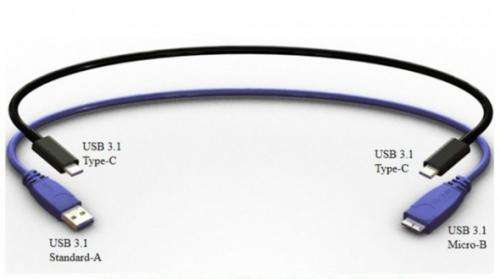(Phys.org) —The USB Implementation Forum has announced at the Intel Developer Forum in China, that the proposed Type-C USB connector has been approved—it will be finalized later this summer with products using the new standard out, likely before the holiday season. It is intended to replace both the Type-A and Type-B USB connector.
The USB (Type A and B) port has been with us now for a long enough time that we've all become numb to its imperfections—cords have to be plugged right side up and the right end into the right device. All that is about to change now as the new cords will have identical connectors on both ends and can be plugged in regardless of orientation.
The Implementation Forum first began considering the changeover this past December—now just four months later, they've come to a decision. The only drawback to the new connector standard appears to be a lack of backwards compatibility.
USB Type-C will be much smaller than the current standard, though not as small as the micro sized cable connectors used on many smartphones. Whether device makers will deem it small enough for phones and tablets remains to be seen. Also, there appears to be a very good chance that computer makers will retain some of the old standard ports and simply add some of the new as well, making sure consumers can use either if they so choose.
In addition to its small size (just 8.3x2.5mm) the new standard will also allow for the maximum USB 3.1 specification throughput rate of 10Gps (and still allow for higher rates in the future). Also, in another nod to user complaints, the new connectors will make an audible click when fully inserted. Certified plugs must also be able to last up to 10,000 plug/unpluggings. One small challenge for the new standard will be a renewed push by some in the industry to settle on a wireless USB standard, which could at some point make all cable USB connectors moot.
The new standard isn't likely to revolutionize the consumer electronics industry, but it will almost assuredly bring smiles to the faces of those in the future remembering the ire at having to make several attempts at simply plugging in a device with the old cable
More information: www.usb.org/
© 2014 Phys.org






















